咖啡发展史英文介绍coffee
- 格式:ppt
- 大小:9.49 MB
- 文档页数:24
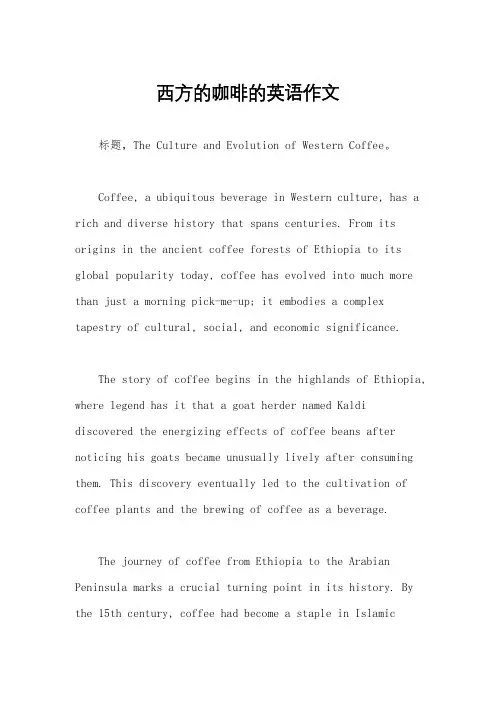
西方的咖啡的英语作文标题,The Culture and Evolution of Western Coffee。
Coffee, a ubiquitous beverage in Western culture, has a rich and diverse history that spans centuries. From its origins in the ancient coffee forests of Ethiopia to its global popularity today, coffee has evolved into much more than just a morning pick-me-up; it embodies a complex tapestry of cultural, social, and economic significance.The story of coffee begins in the highlands of Ethiopia, where legend has it that a goat herder named Kaldi discovered the energizing effects of coffee beans after noticing his goats became unusually lively after consuming them. This discovery eventually led to the cultivation of coffee plants and the brewing of coffee as a beverage.The journey of coffee from Ethiopia to the Arabian Peninsula marks a crucial turning point in its history. By the 15th century, coffee had become a staple in Islamicculture, with coffee houses, known as qahveh khaneh, springing up in cities like Constantinople, Damascus, and Cairo. These coffee houses quickly became centers of social activity, where people gathered to engage in lively discussions, listen to music, and even play games.The spread of coffee to Europe in the 17th century brought about a new wave of coffee culture. Coffeehouses, or "penny universities" as they were called due to the intellectual conversations held within, became popular across the continent. In cities like London, Paris, and Vienna, coffeehouses became hubs of innovation, where artists, writers, philosophers, and businessmen congregated to exchange ideas and debate the issues of the day.The 18th century saw the rise of coffee as a global commodity, thanks in part to European colonial powers establishing coffee plantations in regions like the Caribbean, Central and South America, and Southeast Asia. The advent of coffee cultivation on a large scale transformed it from a luxury enjoyed by the elite to a beverage accessible to people from all walks of life.In the United States, coffee played a pivotal role in the country's history, particularly during the American Revolution. The Boston Tea Party of 1773, in whichcolonists protested British taxation by dumping tea into Boston Harbor, sparked a shift towards coffee consumption as a symbol of independence. Coffee became entrenched in American culture, with coffeehouses serving as meeting places for revolutionaries and intellectuals alike.The 20th century witnessed the rise of coffee as a global commodity, with multinational corporations like Starbucks playing a central role in shaping modern coffee culture. Starbucks, founded in Seattle in 1971, popularized the concept of the "third place," a social environment distinct from home and work where people could gather and connect over coffee.Today, coffee culture continues to evolve, with specialty coffee shops and artisanal roasters gaining popularity in cities around the world. The emphasis on quality, sustainability, and fair trade practices has ledto a renaissance in coffee appreciation, with consumers increasingly seeking out unique and ethically sourced beans.In conclusion, the history of Western coffee is a testament to its enduring appeal and cultural significance. From its humble origins in Ethiopia to its global prominence today, coffee has transcended its role as a mere beverage to become a symbol of social interaction, creativity, and community. As we continue to embrace therich diversity of coffee culture, we honor the traditionsof the past while embracing the innovations of the future.This essay, inspired by the rich history and cultural significance of Western coffee, highlights the evolution of coffee from its origins in Ethiopia to its global prominence today. Through exploring the cultural, social, and economic impact of coffee, we gain a deeperappreciation for this beloved beverage and the role itplays in shaping our world.。
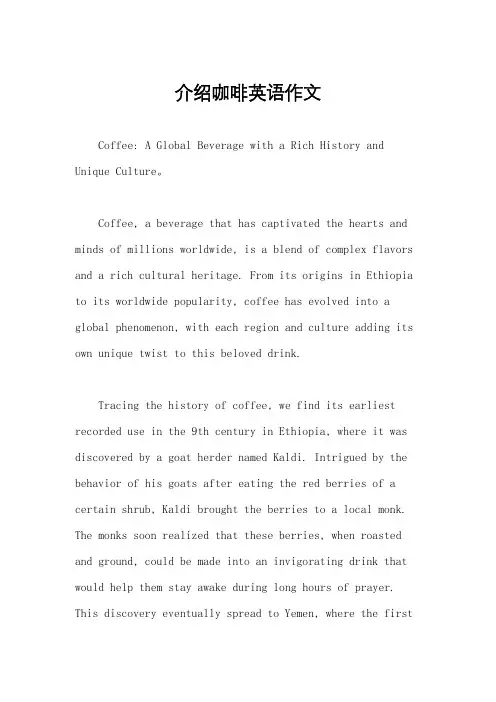
矿产资源开发利用方案编写内容要求及审查大纲
矿产资源开发利用方案编写内容要求及《矿产资源开发利用方案》审查大纲一、概述
㈠矿区位置、隶属关系和企业性质。
如为改扩建矿山, 应说明矿山现状、
特点及存在的主要问题。
㈡编制依据
(1简述项目前期工作进展情况及与有关方面对项目的意向性协议情况。
(2 列出开发利用方案编制所依据的主要基础性资料的名称。
如经储量管理部门认定的矿区地质勘探报告、选矿试验报告、加工利用试验报告、工程地质初评资料、矿区水文资料和供水资料等。
对改、扩建矿山应有生产实际资料, 如矿山总平面现状图、矿床开拓系统图、采场现状图和主要采选设备清单等。
二、矿产品需求现状和预测
㈠该矿产在国内需求情况和市场供应情况
1、矿产品现状及加工利用趋向。
2、国内近、远期的需求量及主要销向预测。
㈡产品价格分析
1、国内矿产品价格现状。
2、矿产品价格稳定性及变化趋势。
三、矿产资源概况
㈠矿区总体概况
1、矿区总体规划情况。
2、矿区矿产资源概况。
3、该设计与矿区总体开发的关系。
㈡该设计项目的资源概况
1、矿床地质及构造特征。
2、矿床开采技术条件及水文地质条件。
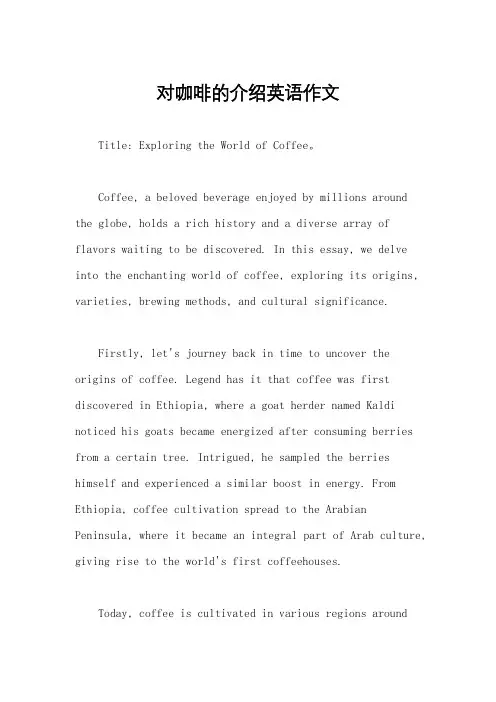
对咖啡的介绍英语作文Title: Exploring the World of Coffee。
Coffee, a beloved beverage enjoyed by millions around the globe, holds a rich history and a diverse array of flavors waiting to be discovered. In this essay, we delve into the enchanting world of coffee, exploring its origins, varieties, brewing methods, and cultural significance.Firstly, let's journey back in time to uncover the origins of coffee. Legend has it that coffee was first discovered in Ethiopia, where a goat herder named Kaldi noticed his goats became energized after consuming berries from a certain tree. Intrigued, he sampled the berries himself and experienced a similar boost in energy. From Ethiopia, coffee cultivation spread to the Arabian Peninsula, where it became an integral part of Arab culture, giving rise to the world's first coffeehouses.Today, coffee is cultivated in various regions aroundthe world, each offering its unique flavors and characteristics. The "coffee belt," located between the Tropics of Cancer and Capricorn, encompasses regions such as Latin America, Africa, and Asia, where the climate and altitude create ideal conditions for coffee cultivation. Within this belt, different varieties of coffee beans thrive, including Arabica and Robusta, each with its distinctive taste profile.Arabica beans are known for their smooth, complex flavors with notes of fruit and floral undertones, while Robusta beans are prized for their bold, earthy flavor and higher caffeine content. Coffee aficionados often seek out single-origin coffees, which are sourced from a specific region and showcase the unique terroir of that area. Whether it's the fruity acidity of Ethiopian Yirgacheffe or the chocolatey richness of Colombian Supremo, each cuptells a story of its origin.Brewing coffee is both an art and a science, with various methods allowing for different flavor profiles to shine. From the classic drip coffee maker to the precisepour-over technique and the rich, full-bodied immersion brew of French press, coffee lovers have a multitude of options to explore. Espresso, the concentrated coffee brewed by forcing hot water through finely-ground coffee beans, serves as the foundation for many beloved coffee beverages, including cappuccinos, lattes, and macchiatos.Beyond its culinary delights, coffee plays asignificant role in cultures around the world. In Italy, the espresso bar is a social hub where locals gather to catch up with friends and start their day with a shot of espresso. In Ethiopia, the coffee ceremony is a time-honored tradition where beans are roasted, ground, and brewed in a ceremonial fashion, symbolizing hospitality and community.In addition to its cultural significance, coffee has also inspired art, literature, and music. From the vibrant paintings of café scenes by artists like Vincent van Gogh to the literary works penned in the cozy corners of coffeehouses, the beverage has left an indelible mark on human creativity.In conclusion, coffee is much more than just a beverage—it's a journey of discovery, connecting people across continents and cultures. Whether sipped slowly in a quaint café or brewed at home with care and precision, each cup of coffee offers a glimpse into the rich tapestry of our world. So let's raise our mugs and toast to the endless possibilities awaiting us in the world of coffee. Cheers!。
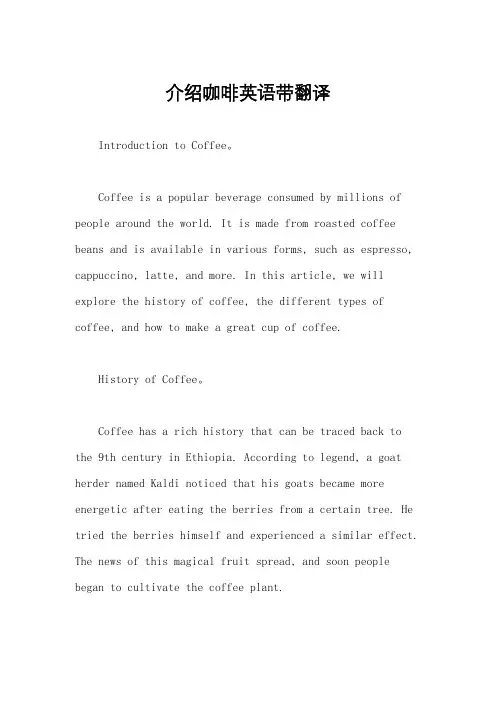
介绍咖啡英语带翻译Introduction to Coffee。
Coffee is a popular beverage consumed by millions of people around the world. It is made from roasted coffee beans and is available in various forms, such as espresso, cappuccino, latte, and more. In this article, we will explore the history of coffee, the different types of coffee, and how to make a great cup of coffee.History of Coffee。
Coffee has a rich history that can be traced back to the 9th century in Ethiopia. According to legend, a goat herder named Kaldi noticed that his goats became more energetic after eating the berries from a certain tree. He tried the berries himself and experienced a similar effect. The news of this magical fruit spread, and soon people began to cultivate the coffee plant.The first coffee shop opened in Istanbul, Turkey in the 15th century, and coffee soon became a popular drink in the Middle East. In the 17th century, coffee was introduced to Europe, and coffeehouses began to appear in cities like London and Paris. Today, coffee is enjoyed all over the world and is an integral part of many cultures.Types of Coffee。
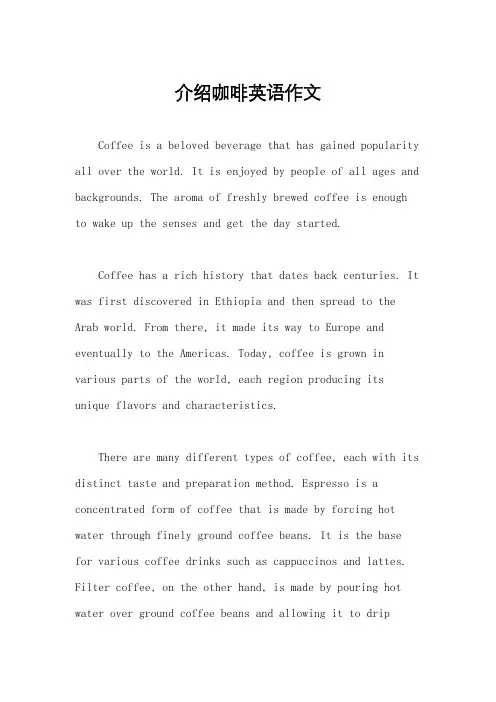
介绍咖啡英语作文Coffee is a beloved beverage that has gained popularity all over the world. It is enjoyed by people of all ages and backgrounds. The aroma of freshly brewed coffee is enough to wake up the senses and get the day started.Coffee has a rich history that dates back centuries. It was first discovered in Ethiopia and then spread to the Arab world. From there, it made its way to Europe and eventually to the Americas. Today, coffee is grown in various parts of the world, each region producing its unique flavors and characteristics.There are many different types of coffee, each with its distinct taste and preparation method. Espresso is a concentrated form of coffee that is made by forcing hot water through finely ground coffee beans. It is the basefor various coffee drinks such as cappuccinos and lattes. Filter coffee, on the other hand, is made by pouring hot water over ground coffee beans and allowing it to dripthrough a filter. This method produces a milder and less concentrated flavor.Coffee is not just a drink; it has become a part of people's daily routines and social gatherings. Many people cannot imagine starting their day without a cup of coffee. It is a way to relax, socialize, and enjoy a moment of solitude. Coffee shops have become popular meeting places for friends and colleagues to catch up and discuss various topics.In addition to its taste and social aspects, coffee also has various health benefits. It is known to boost energy levels, improve focus and concentration, and even provide antioxidants. However, it is essential to consume coffee in moderation as excessive intake can lead to negative effects such as insomnia and increased heart rate.Coffee has also become a source of inspiration for artists and writers. Many creative minds find solace and inspiration in a cup of coffee. It is a symbol ofcreativity and productivity. Some even believe that thearoma of coffee can stimulate the brain and enhance cognitive function.In conclusion, coffee is more than just a beverage; it is a cultural phenomenon. Its rich history, various types, and social aspects make it a beloved drink worldwide. Whether enjoyed alone or in the company of others, coffee has a way of bringing people together and adding a touch of warmth to everyday life. So next time you sip on a cup of coffee, take a moment to appreciate the journey it has taken to reach your hands and the joy it brings to your senses.。
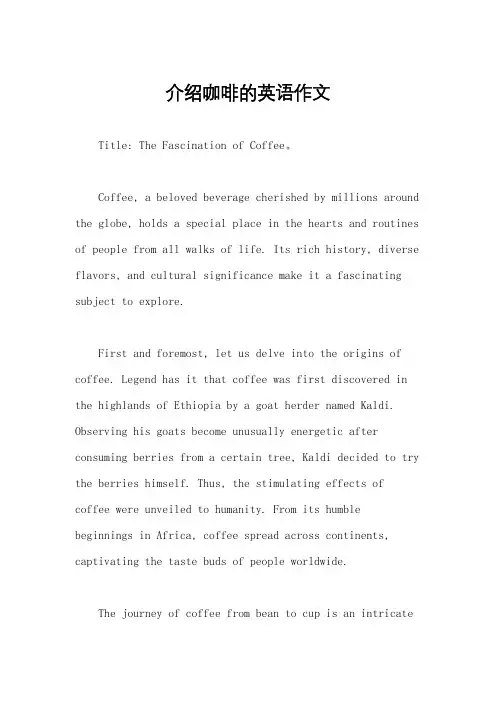
介绍咖啡的英语作文Title: The Fascination of Coffee。
Coffee, a beloved beverage cherished by millions around the globe, holds a special place in the hearts and routines of people from all walks of life. Its rich history, diverse flavors, and cultural significance make it a fascinating subject to explore.First and foremost, let us delve into the origins of coffee. Legend has it that coffee was first discovered in the highlands of Ethiopia by a goat herder named Kaldi. Observing his goats become unusually energetic after consuming berries from a certain tree, Kaldi decided to try the berries himself. Thus, the stimulating effects of coffee were unveiled to humanity. From its humble beginnings in Africa, coffee spread across continents, captivating the taste buds of people worldwide.The journey of coffee from bean to cup is an intricateprocess, involving cultivation, harvesting, roasting, and brewing. Coffee beans are typically grown in tropical regions, with countries like Brazil, Colombia, and Ethiopia being prominent producers. The beans are meticulously harvested by hand to ensure optimal ripeness, then processed to remove the outer layers before being roasted to perfection. The roasting process is crucial, as it greatly influences the flavor profile of the final brew. Light roasts tend to preserve the bean's natural flavors, while dark roasts offer a bolder, more intense taste.Once the beans are roasted, they are ready to be transformed into a delightful cup of coffee. Brewing methods vary widely, ranging from the classic drip coffee maker to the sophisticated espresso machine. Each method imparts its unique characteristics to the final brew, allowing coffee enthusiasts to experiment and discovertheir preferred taste preferences.Beyond its exquisite flavor, coffee plays a significant role in various cultures around the world. In many societies, coffee is more than just a beverage – it is asocial ritual, a symbol of hospitality, and a means of forging connections. Whether it's the Italian tradition of savoring espresso at a bustling café or the Japanese art of meticulously preparing pour-over coffee, the rituals surrounding coffee reflect the values and customs of different communities.Moreover, coffee has permeated popular culture, inspiring literature, art, and even music. Countlesswriters have sought solace in the company of a cup of coffee, finding inspiration in its invigorating aroma and stimulating effects. Artists, too, have been captivated by coffee's allure, depicting its imagery in paintings, sculptures, and photographs. From jazz musicians crooning about the virtues of "black coffee" to filmmakers showcasing the intimate conversations that unfold over a shared cup, coffee has left an indelible mark on the creative landscape.In addition to its cultural significance, coffee boasts a myriad of health benefits. Studies have shown that moderate coffee consumption may reduce the risk of certaindiseases, such as Parkinson's disease, Alzheimer's disease, and type 2 diabetes. Furthermore, coffee is a rich source of antioxidants, which help protect the body against oxidative stress and inflammation. However, it is essential to consume coffee in moderation and be mindful of added sugars and unhealthy additives that can negate itshealthful properties.In conclusion, coffee transcends its status as a mere beverage, embodying a complex tapestry of history, culture, and flavor. From its humble origins in Ethiopia to its ubiquitous presence in cafes around the world, coffee continues to captivate the senses and ignite the imagination of people everywhere. So, whether you prefer a velvety latte, a bold espresso, or a fragrant pour-over, raise your cup to the enchanting world of coffee – a testament to the beauty of discovery and the joy of shared moments.。
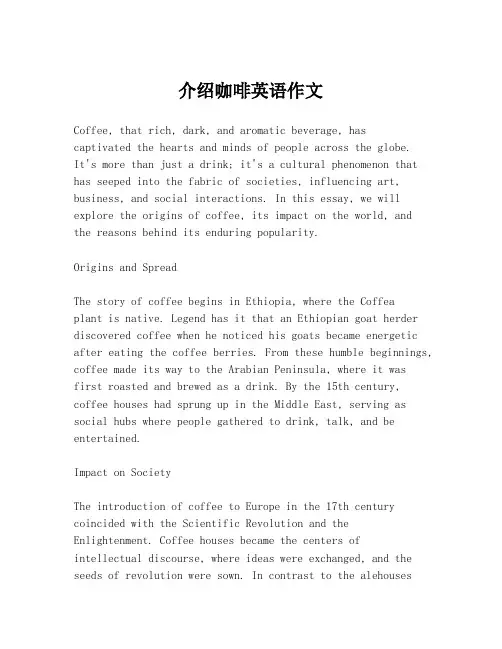
介绍咖啡英语作文Coffee, that rich, dark, and aromatic beverage, hascaptivated the hearts and minds of people across the globe.It's more than just a drink; it's a cultural phenomenon that has seeped into the fabric of societies, influencing art, business, and social interactions. In this essay, we will explore the origins of coffee, its impact on the world, andthe reasons behind its enduring popularity.Origins and SpreadThe story of coffee begins in Ethiopia, where the Coffeaplant is native. Legend has it that an Ethiopian goat herder discovered coffee when he noticed his goats became energetic after eating the coffee berries. From these humble beginnings, coffee made its way to the Arabian Peninsula, where it wasfirst roasted and brewed as a drink. By the 15th century, coffee houses had sprung up in the Middle East, serving as social hubs where people gathered to drink, talk, and be entertained.Impact on SocietyThe introduction of coffee to Europe in the 17th century coincided with the Scientific Revolution and the Enlightenment. Coffee houses became the centers ofintellectual discourse, where ideas were exchanged, and the seeds of revolution were sown. In contrast to the alehousesof the time, coffee houses were seen as more civilized and conducive to deep conversation and thought.Economic InfluenceCoffee has had a profound economic impact as well. It has been a driving force behind trade and colonization, with countries vying for control over coffee-growing regions. The coffee industry today is a multi-billion-dollar market, supporting millions of small farmers and contributing significantly to the economies of producing countries.Cultural SignificanceCoffee has become a cultural symbol of wakefulness, productivity, and social connection. The ritual of brewing and drinking coffee is a daily routine for many, providing a moment of solace or a break from the hustle and bustle of life. It's also a social lubricant, often shared amongfriends and colleagues, fostering a sense of community and camaraderie.Health PerspectivesDespite concerns about caffeine intake, moderate coffee consumption has been associated with various health benefits. Studies suggest that coffee can improve cognitive function, reduce the risk of certain diseases like Parkinson's and Alzheimer's, and even extend life expectancy when consumed in moderation.The Coffee ExperienceThe experience of coffee is subjective and deeply personal. Some prefer it black, savoring the complex flavors of a single-origin bean. Others enjoy it with milk or sugar, creating a comforting, familiar taste. The process of making coffee, whether it's a pour-over, French press, or espresso, is an art form in itself, with each method bringing out different characteristics of the coffee.ConclusionCoffee is more than a simple drink; it's a cultural icon that has shaped history, economies, and daily life. It's a symbol of comfort, a catalyst for conversation, and a source of livelihood for countless individuals around the world. As we raise our cups to the next chapter in the story of coffee, we toast to the simple yet profound pleasure it brings to our lives.。

有关咖啡的英语阅读Coffee: A Brewed History, Health Impacts, and Brewing Techniques.Origins and History.The origins of coffee trace back to the ancient highlands of Ethiopia, where legend has it that a goat herder named Kaldi observed his goats becoming unusually energetic after consuming berries from a certain tree. Intrigued, he tasted the berries himself and experienced a similar invigorating effect.From Ethiopia, coffee spread to Arabia, where it gained popularity in Sufi monasteries as a stimulant for all-night prayer sessions. By the 16th century, coffee was introduced to Europe through trade with the Ottoman Empire, quickly becoming a favorite beverage among intellectuals and royalty.Varieties and Cultivation.Coffee is derived from the roasted seeds (beans) of the Coffea plant, of which there are two main species: Arabica and Robusta. Arabica, native to Ethiopia, is renowned for its delicate flavor and aroma, while Robusta, originatingin Central and West Africa, is known for its highercaffeine content and more bitter taste.Coffee plants thrive in tropical climates with richsoil and abundant rainfall. They are typically cultivatedin large plantations, where the beans are harvested by hand or machine when ripe. After harvesting, the beans are processed to remove the outer pulp and parchment, revealing the green coffee beans.Health Impacts.Coffee has been the subject of extensive scientific research, with mixed findings on its health effects. Some studies have linked moderate coffee consumption (2-4 cups per day) to potential health benefits, including:Reduced Risk of Type 2 Diabetes: Coffee contains compounds that may improve insulin sensitivity and reducethe risk of developing type 2 diabetes.Improved Cognitive Function: Caffeine, a key component of coffee, has been shown to enhance alertness, memory, and cognitive performance.Antioxidant Properties: Coffee is a rich source of antioxidants, which may help protect cells from damage and reduce the risk of chronic diseases.However, excessive coffee intake or consumption at inappropriate times can also have negative effects, such as:Anxiety and Sleep Disturbances: High levels ofcaffeine can lead to anxiety, restlessness, and disrupted sleep.Increased Blood Pressure: Coffee can temporarily raise blood pressure, especially in individuals with pre-existinghypertension.Pregnancy Risks: Excessive coffee consumption during pregnancy has been linked to an increased risk of low birth weight and premature birth.Brewing Techniques.The art of brewing coffee involves extracting the desired flavors and aromas from the roasted beans. There are numerous brewing methods, each producing a unique taste profile:Drip Coffee: Hot water is poured over ground coffee in a filter paper, allowing the brewed coffee to drip into a carafe.French Press: Ground coffee is steeped in hot waterfor a few minutes, then pressed down to separate the grounds from the coffee.Pour Over: Hot water is manually poured over groundcoffee in a cone-shaped filter, creating a smooth and balanced brew.Espresso: Finely ground coffee is tamped tightly intoa portafilter and extracted with pressurized hot water, producing a concentrated, flavorful beverage.Cold Brew: Ground coffee is steeped in cold water for an extended period (12-24 hours), resulting in a lessacidic and more mellow coffee.Cultural Significance.Coffee has become an integral part of many cultures around the world. In some countries, such as Ethiopia and Turkey, coffee ceremonies are an important social tradition. In others, coffeehouses have served as hubs forintellectual discussion and artistic expression.From its humble origins in the Ethiopian highlands toits widespread popularity today, coffee has played asignificant role in history, culture, and the daily lives of people worldwide.。
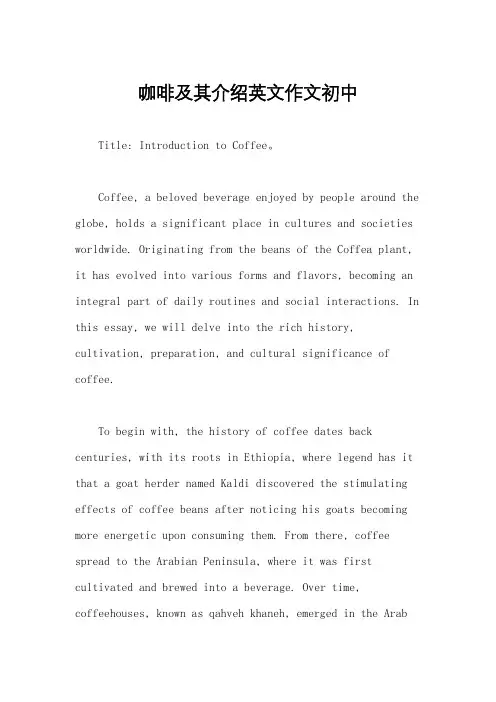
咖啡及其介绍英文作文初中Title: Introduction to Coffee。
Coffee, a beloved beverage enjoyed by people around the globe, holds a significant place in cultures and societies worldwide. Originating from the beans of the Coffea plant, it has evolved into various forms and flavors, becoming an integral part of daily routines and social interactions. In this essay, we will delve into the rich history, cultivation, preparation, and cultural significance of coffee.To begin with, the history of coffee dates back centuries, with its roots in Ethiopia, where legend has it that a goat herder named Kaldi discovered the stimulating effects of coffee beans after noticing his goats becoming more energetic upon consuming them. From there, coffee spread to the Arabian Peninsula, where it was first cultivated and brewed into a beverage. Over time, coffeehouses, known as qahveh khaneh, emerged in the Arabworld, serving as centers for socialization, intellectual discourse, and entertainment.Today, coffee is grown in regions known as the "Coffee Belt," situated between the Tropics of Cancer and Capricorn. Countries such as Brazil, Colombia, Ethiopia, and Vietnam are among the top producers of coffee beans. Thecultivation of coffee requires specific climatic conditions, including a steady temperature, rainfall, and altitude, which contribute to the unique flavors and characteristicsof different coffee varieties.The two main species of coffee plants cultivated for consumption are Arabica and Robusta. Arabica beans areprized for their delicate flavors, aromatic qualities, and higher acidity, while Robusta beans are known for their bold, bitter taste and higher caffeine content. The process of coffee cultivation involves planting, nurturing, and harvesting the coffee cherries, which contain the coffee beans. After harvesting, the beans undergo processing methods such as wet or dry processing, which influencetheir flavor profile.Once the coffee beans are processed, they are roastedto perfection, a crucial step that enhances their flavorand aroma. Roasting brings out the complex flavors and oils within the beans, resulting in a spectrum of tastes ranging from light and fruity to dark and robust. The degree of roasting significantly impacts the final flavor of the coffee, with lighter roasts preserving more of the bean's original characteristics, while darker roasts develop richer, smokier flavors.After roasting, the coffee beans are ground and brewed into a variety of beverages, including espresso, cappuccino, latte, and americano, among others. Each brewing method extracts different compounds from the coffee grounds, resulting in distinct flavors, strengths, and textures. Whether brewed using an espresso machine, French press,pour-over, or drip coffee maker, the art of coffee preparation allows for endless experimentation and customization to suit individual preferences.Beyond its role as a morning pick-me-up, coffee holdsimmense cultural significance in societies around the world. Coffeehouses serve as gathering places for friends, colleagues, and communities to socialize, relax, and exchange ideas. In some cultures, such as Italy and Turkey, coffee rituals are deeply ingrained in daily life, with specific customs and traditions associated with its consumption.In conclusion, coffee is much more than just a beverage—it is a global phenomenon that transcends borders, cultures, and generations. From its humble beginnings in Ethiopia to its widespread cultivation and consumption today, coffee continues to captivate people with its rich flavors, aromas, and cultural significance. Whether enjoyed alone or shared with others, a cup of coffee represents moments of comfort, connection, and contemplation in anever-changing world.。
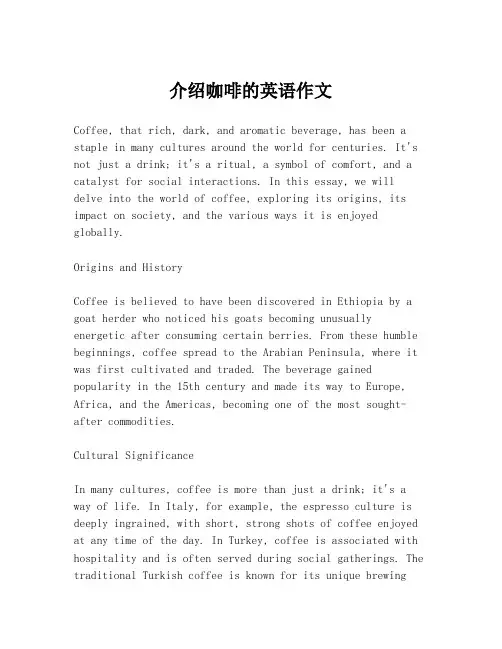
介绍咖啡的英语作文Coffee, that rich, dark, and aromatic beverage, has been a staple in many cultures around the world for centuries. It's not just a drink; it's a ritual, a symbol of comfort, and a catalyst for social interactions. In this essay, we will delve into the world of coffee, exploring its origins, its impact on society, and the various ways it is enjoyed globally.Origins and HistoryCoffee is believed to have been discovered in Ethiopia by a goat herder who noticed his goats becoming unusually energetic after consuming certain berries. From these humble beginnings, coffee spread to the Arabian Peninsula, where it was first cultivated and traded. The beverage gained popularity in the 15th century and made its way to Europe, Africa, and the Americas, becoming one of the most sought-after commodities.Cultural SignificanceIn many cultures, coffee is more than just a drink; it's a way of life. In Italy, for example, the espresso culture is deeply ingrained, with short, strong shots of coffee enjoyed at any time of the day. In Turkey, coffee is associated with hospitality and is often served during social gatherings. The traditional Turkish coffee is known for its unique brewingmethod and the fortune-telling practice that follows its consumption.The Coffeehouse ExperienceCoffeehouses, or cafés, have been a hub for social and intellectual exchange since the 16th century. They are places where people meet to discuss literature, politics, and art over a cup of coffee. The modern coffeehouse, epitomized by chains like Starbucks, has evolved to include a broader range of beverages and a more casual atmosphere, but the essence of community remains.Types and VarietiesCoffee comes in a multitude of types and flavors, influenced by the bean's origin, roast level, and brewing method. Arabica beans are known for their mild and sweet taste, while Robusta beans offer a stronger, more bitter flavor. The roasting process can transform the coffee's taste from light and acidic to dark and smoky. Brewing methods, such as drip coffee, French press, or espresso, also contribute to the final taste profile of the coffee.Health and CaffeineCoffee is not just a source of pleasure; it has been linked to various health benefits due to its antioxidant content. Moderate coffee consumption has been associated with a reduced risk of diseases such as Parkinson's, Alzheimer's, and certain types of cancer. However, it's the caffeine incoffee that provides the well-known boost in alertness and concentration, making it a popular choice for students and professionals alike.The Art of Coffee MakingThe craft of making coffee has evolved into an art form, with baristas mastering the skill of espresso making, latte art, and the perfect pour-over. The Specialty Coffee Association and barista championships around the world celebrate the artistry and expertise in the coffee-making process.ConclusionCoffee's journey from a simple agricultural product to a global phenomenon reflects its deep cultural significance and the joy it brings to millions. It's a drink that transcends borders, uniting people in the shared experience of savoring its rich flavors. Whether you prefer it black, with milk, or in a flavored latte, coffee continues to be a beloved part of our daily routines and social lives.。
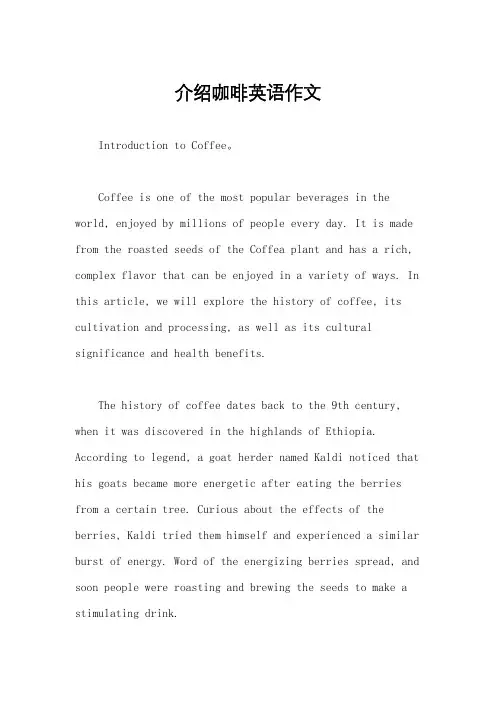
介绍咖啡英语作文Introduction to Coffee。
Coffee is one of the most popular beverages in the world, enjoyed by millions of people every day. It is made from the roasted seeds of the Coffea plant and has a rich, complex flavor that can be enjoyed in a variety of ways. In this article, we will explore the history of coffee, its cultivation and processing, as well as its cultural significance and health benefits.The history of coffee dates back to the 9th century, when it was discovered in the highlands of Ethiopia. According to legend, a goat herder named Kaldi noticed that his goats became more energetic after eating the berries from a certain tree. Curious about the effects of the berries, Kaldi tried them himself and experienced a similar burst of energy. Word of the energizing berries spread, and soon people were roasting and brewing the seeds to make a stimulating drink.Coffee cultivation and processing have evolved significantly since its discovery in Ethiopia. Today, coffee is grown in over 70 countries around the world, with the majority of production taking place in the "Coffee Belt" – the region between the Tropics of Cancer and Capricorn. The process of growing coffee involves planting the seeds in nurseries, transplanting the seedlings to shaded areas, and then harvesting the ripe coffee cherries. The cherries are then processed to remove the outer layers and extract the beans, which are then dried and roasted to perfection.In addition to its rich history and complex cultivation process, coffee holds great cultural significance in many societies. It is often enjoyed as a social beverage, bringing people together for conversations and relaxation. In some cultures, coffee ceremonies are an important part of social gatherings, symbolizing hospitality and friendship. Furthermore, coffee has inspired countless works of art, literature, and music, becoming a symbol of creativity and intellectualism.Aside from its cultural significance, coffee alsooffers a number of health benefits. Studies have shown that moderate coffee consumption can reduce the risk of certain diseases, such as Parkinson's disease, type 2 diabetes, and liver cancer. Additionally, coffee is rich in antioxidants and nutrients, which can contribute to overall health and well-being. However, it is important to note that excessive consumption of coffee can lead to negative health effects, such as insomnia, anxiety, and digestive issues.In conclusion, coffee is a beloved beverage with a fascinating history, intricate cultivation process, and significant cultural and health benefits. Whether enjoyedin the form of a rich espresso, a creamy latte, or a simple black brew, coffee continues to be an integral part ofdaily life for many people around the world. Its unique flavors and stimulating effects make it a timeless favorite, and its cultural and health significance only add to its allure.。
Coffee,a beverage that has captivated the world with its rich aroma and invigorating taste,is more than just a simple drink it is a cultural phenomenon that has shaped societies and economies across the globe.This essay will delve into the history of coffee, its production process,the different types of coffee,and its impact on social life.The History of CoffeeThe story of coffee dates back to the15th century in Ethiopia,where it was discovered by a goat herder who noticed his goats becoming energetic after consuming the berries from a certain tree.From Ethiopia,the drink spread to the Arabian Peninsula,where it was first cultivated and then introduced to the rest of the world.Coffee houses,or qahveh khaneh, became popular in the Middle East,serving as social hubs where people gathered to discuss politics,literature,and philosophy.The Production ProcessThe journey from bean to cup is a complex one.Coffee begins as a cherrylike fruit that contains two beans inside.These beans are harvested,dried,and then roasted to varying degrees to develop their flavor profiles.The roasting process not only affects the flavor but also determines the caffeine content,with lighter roasts typically having more caffeine.After roasting,the beans are ground and brewed using various methods such as drip coffee,espresso,or French press.Types of CoffeeThe world of coffee is vast and diverse,with numerous types and blends to suit every palate.Arabica beans are known for their mild and sweet flavor,while Robusta beans are more robust and bitter.Specialty coffees,such as singleorigin or blends,offer unique flavor profiles influenced by the beans terroir.Espresso,a concentrated form of coffee,is the base for many popular drinks like lattes,cappuccinos,and macchiatos.The Social Impact of CoffeeCoffee has played a significant role in social life,from the intellectual debates in17thcentury England to the modernday coffee shop culture.It is a place where people meet to work,socialize,and relax.The rise of coffee shops has also been linked to the growth of urbanization and the development of a more cosmopolitan lifestyle.Today, coffee shops are not just about the coffee they are about the experience,the ambiance, and the community they foster.ConclusionCoffee is more than an energy boost it is a symbol of cultural exchange,a catalyst for social interaction,and a testament to human ingenuity in cultivating and processing a simple bean into a complex and cherished drink.As we enjoy our morning cup or an afternoon espresso,we are partaking in a tradition that has spanned centuries and connected people across continents.Whether its the invigorating aroma that wakes us up or the comforting warmth that accompanies us through the day,coffee remains an integral part of our lives and a testament to its enduring appeal.。
Coffee,a beverage that has captivated the hearts and minds of people across the globe,has a rich history and a profound impact on culture and society.The following essay delves into the world of coffee,exploring its origins,the process of making it,and its role in social interactions.Origins of CoffeeThe story of coffee begins in Ethiopia,where the coffee plant is believed to have been discovered by a goat herder who noticed his animals becoming more energetic after eating the berries.From there,the cultivation of coffee spread to the Arabian Peninsula, where it was first consumed as a beverage in the15th century.The popularity of coffee grew,and it eventually made its way to Europe,where it became a staple in the daily lives of many.The Process of Making CoffeeThe journey from coffee bean to the cup begins with the selection of highquality beans. These beans are then roasted to bring out their unique flavors and aromas.The roasting process can vary in temperature and duration,resulting in beans with different characteristics,ranging from light and acidic to dark and bold.Once roasted,the beans are ground to a fine consistency,which increases the surface area and allows the water to extract the flavors more efficiently.The brewing process itself can take many forms,from the simple drip coffee maker to the more complex espresso machines.Regardless of the method,the goal is to achieve a perfect balance of bitterness and acidity that results in a rich,satisfying cup of coffee.The Social Aspect of CoffeeCoffee has long been associated with social gatherings.In many cultures,it is customary to offer coffee to guests as a sign of hospitality.Cafés have served as meeting places for centuries,where people come together to discuss ideas,conduct business,or simply enjoy each others company.The tradition of coffeehouses in Europe during the Enlightenment period is a testament to the role of coffee in fostering intellectual and social exchanges. Health Benefits and ConcernsWhile coffee is enjoyed for its taste and social benefits,it also has potential health implications.Moderate consumption of coffee has been linked to a reduced risk of certain diseases,such as Parkinsons and Alzheimers.However,excessive intake can lead tonegative effects,including increased heart rate and potential sleep disturbances. ConclusionIn conclusion,coffee is more than just a drink it is a cultural phenomenon that has shaped societies and economies worldwide.From its humble beginnings in Ethiopia to its current status as a global commodity,coffees journey is a testament to the power of a single plant to transform the world.Whether enjoyed as a morning ritual or a social lubricant,coffee continues to be a beloved part of daily life for millions around the globe.。
关于咖啡的英语作文Title: The Art and Culture of Coffee。
Introduction:Coffee, a beloved beverage enjoyed by millions worldwide, holds a significant place in both cultural and culinary realms. From its origins in Ethiopia to its global spread, coffee has evolved into much more than a mere drink. In this essay, we will delve into the rich history,cultural significance, and diverse preparation methods of coffee.Historical Roots:The story of coffee begins in the highlands of Ethiopia, where, according to legend, a goat herder named Kaldi discovered the energizing effects of coffee beans after observing his goats becoming unusually lively upon consuming them. From Ethiopia, coffee cultivation spread tothe Arabian Peninsula, where it gained popularity for its stimulating properties. By the 15th century, coffee had become an integral part of Arabic culture, with the first coffeehouses, known as qahveh khaneh, emerging in cities like Constantinople and Cairo.Cultural Significance:Coffeehouses soon became centers of social activity, where people gathered to engage in lively discussions, share news, and enjoy the invigorating beverage. These establishments played a pivotal role in the exchange of ideas and the development of intellectual thought, earning them the nickname "Schools of the Wise." The tradition of coffee drinking continued to spread throughout the Ottoman Empire and into Europe, where coffeehouses became synonymous with intellectual discourse and cultural exchange.Coffee Rituals:Across different cultures, coffee is celebrated throughvarious rituals and preparation methods. In Ethiopia, the traditional coffee ceremony, known as "bunna," is a symbol of hospitality and community. It involves roasting green coffee beans over an open flame, grinding them by hand, and brewing them in a special pot called a "jebena." In Italy, espresso reigns supreme, served in small, potent shots that pack a flavorful punch. Meanwhile, in countries like Turkey and Greece, coffee is prepared using unique methods like the Turkish ibrik or the Greek briki, resulting in thick, aromatic brews enjoyed with sweet treats like Turkish delight or baklava.Coffee in the Modern World:In the modern era, coffee has become more than just a morning pick-me-up; it has evolved into a global industry worth billions of dollars. From artisanal cafes to multinational chains, the coffee market offers a diverse array of options to suit every taste and preference. Furthermore, the rise of specialty coffee culture has led to increased awareness of factors like bean origin, roasting techniques, and brewing methods, allowingconsumers to appreciate coffee as a complex and nuanced beverage.Conclusion:In conclusion, coffee's journey from its humble beginnings in Ethiopia to its status as a global phenomenon is a testament to its enduring appeal and cultural significance. Whether enjoyed in a bustling cafe or brewed at home with care and precision, coffee continues to bring people together, stimulate conversation, and inspire creativity. As we raise our cups to toast this beloved beverage, let us also celebrate the rich tapestry ofhistory and tradition that accompanies each sip of coffee. Cheers to the art and culture of coffee!。